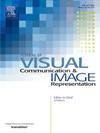DCPNet:用于图像增强的可变形控制点网络
IF 2.6
4区 计算机科学
Q2 COMPUTER SCIENCE, INFORMATION SYSTEMS
Journal of Visual Communication and Image Representation
Pub Date : 2024-10-01
DOI:10.1016/j.jvcir.2024.104308
引用次数: 0
摘要
本文提出了一种由全局和局部色彩增强组成的新型图像增强网络。所提出的网络模型是利用全局变换函数和基于编码器-解码器网络的局部色彩增强网络构建的,全局变换函数由一组片断二次曲线构成。为了自适应地动态控制每条片断曲线的范围,我们引入了可变形控制点(DCP),它决定了全局变换函数的整体结构。片断二次曲线拟合和 DCP 的参数都是通过拟议的 DCP 网络(DCPNet)估算出来的。DCPNet 处理下采样图像,以得出 DCP 参数:DCP 偏移和曲线参数。然后,我们从 DCP 偏移量中获得一组 DCP,并利用曲线参数连接每一对相邻的 DCP,为每个颜色通道构建一个全局变换函数。然后根据得到的变换函数对原始输入图像进行变换,得到全局增强图像。最后,将中间图像输入采用 U-Net 架构的本地增强网络,生成空间增强图像。广泛的实验结果表明,在图像修饰、色调映射和水下图像增强等各种图像增强任务中,所提出的方法优于最先进的方法。本文章由计算机程序翻译,如有差异,请以英文原文为准。
DCPNet: Deformable Control Point Network for image enhancement
In this paper, we present a novel image enhancement network consisting of global and local color enhancement. The proposed network model is constructed using global transformation functions, which are formed by a set of piece-wise quadratic curves and a local color enhancement network based on the encoder–decoder network. To adaptively and dynamically control the ranges of each piece-wise curve, we introduce deformable control points (DCPs), which determine the overall structure of the global transformation functions. The parameters for piece-wise quadratic curve fitting and DCPs are estimated using the proposed DCP network (DCPNet). DCPNet processes a down-sampled image to derive the DCP parameters: The DCP offsets and the curve parameters. Then, we obtain a set of DCPs from the DCP offsets and connect each adjacent DCP pair by using the curve parameter to construct a global transformation function for each color channel. The original input images are then transformed based on the resulting transformation functions to obtain globally enhanced images. Finally, the intermediate image is fed into the local enhancement network, which has a U-Net architecture, to produce the spatially enhanced images. Extensive experimental results demonstrate the superiority of the proposed method over state-of-the-art methods in various image enhancement tasks, such as image retouching, tone-mapping, and underwater image enhancement.
求助全文
通过发布文献求助,成功后即可免费获取论文全文。
去求助
来源期刊

Journal of Visual Communication and Image Representation
工程技术-计算机:软件工程
CiteScore
5.40
自引率
11.50%
发文量
188
审稿时长
9.9 months
期刊介绍:
The Journal of Visual Communication and Image Representation publishes papers on state-of-the-art visual communication and image representation, with emphasis on novel technologies and theoretical work in this multidisciplinary area of pure and applied research. The field of visual communication and image representation is considered in its broadest sense and covers both digital and analog aspects as well as processing and communication in biological visual systems.
 求助内容:
求助内容: 应助结果提醒方式:
应助结果提醒方式:


